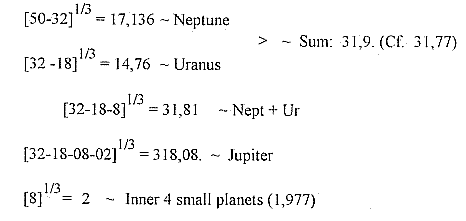| Astronomy / - a 5-dimensional model tested on the planet system and other data - |
|
Astronomy
- links:
|
Elements - links:
|
The Genetic Code -
links:
|
Language - links
|
|
Planet
System - B. Masses
2. Number readings in series 2x2 and root of 10-powers 5-4-3 + 0 |
|
1. The 2x2-series with x = 5-4-3-2-1-0, behind the periodic system: |
© Åsa Wohlin
Free to distribute if the source is mentioned.
Texts are mostly extractions from a booklet series, made publicly available in year 2000
LINKS HEREMACROCOSM1.
Levels PLANET SYSTEM Tables: Planets, Distances in AE 1. Planet distances in AE - Exponent 3/2 2.
Planet distances 3.
Planet distances out of a 4. A graph for planet distances in AE Masses in Earth units 0.
Planet masses 1.
Masses of planets 2.
Masses of planets from 3.
Masses of planets from * Latest updated
|



